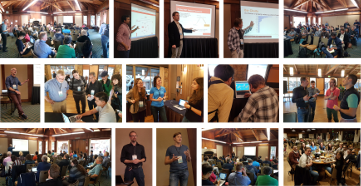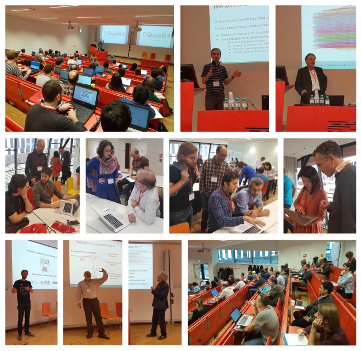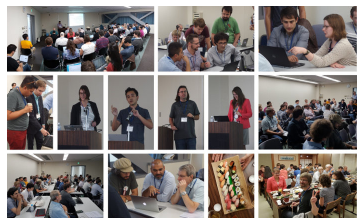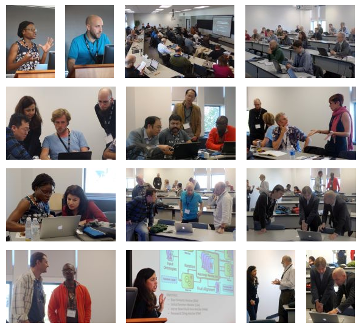Visualization and Interaction for Ontologies and Linked Data
7th International Workshop co-located with ISWC 2022, October 23, 2022, Virtual Workshop

Motivation and Objectives
A picture is worth a thousand words, we often say, yet many areas are in demand of sophisticated visualization techniques, and the Semantic Web is not an exception. The size and complexity of ontologies and Linked Data in the Semantic Web constantly grows and the diverse backgrounds of the users and application areas multiply at the same time. Providing users with visual representations and intuitive interaction techniques can significantly aid the exploration and understanding of the domains and knowledge represented by ontologies and Linked Data.
Ontology visualization is not a new topic and a number of approaches have become available in recent years, with some being already well-established, particularly in the field of ontology modeling. In other areas of ontology engineering, such as ontology alignment and debugging, although several tools have been developed, few provide a graphical user interface, not to mention navigational aids or comprehensive visualization and interaction techniques.
In the presence of a huge network of interconnected resources, one of the challenges faced by the Linked Data community is the visualization of multidimensional datasets to provide for efficient overview, exploration and querying tasks, to mention just a few. With the focus shifting from a Web of Documents to a Web of Data, changes in the interaction paradigms are in demand as well. Novel approaches also need to take into consideration the technological challenges and opportunities given by new interaction contexts, ranging from mobile, touch, and gesture interaction to visualizations on large displays, and encompassing highly responsive web applications.
There is no one-size-fits-all solution but different use cases demand different visualization and interaction techniques. Ultimately, providing better user interfaces, visual representations and interaction techniques will foster user engagement and likely lead to higher quality results in different applications employing ontologies and proliferate the consumption of Linked Data.
Program
The workshop will take place online on October 23rd 14:30 - 18:00 CEST
(link provided by ISWC to registered participants).
Proceedings available here.
14:40 - Opening and Introduction
14:50 Shacled Turtle: Schema-based Turtle Auto-Completion
by Julian Bruyat, Pierre-Antoine Champin, Lionel Médini and Frédérique Laforest
15:20 Enabling Exploratory Search on Manufacturing Knowledge Graphs
by Kevin Haller, Fajar J. Ekaputra, Marta Sabou and Florina Piroi
15:50 Multi-level Visual Tours of Weather Linked Data
Nadia Yacoubi, Damien Graux and Catherine Faron
16:10 Break
16:30 Experience with Visual SPARQL Queries over DBPedia
by Kārlis Čerāns, Jūlija Ovčiņņikova, Mikus Grasmanis, Lelde Lāce
16:50 Toward a Comparison Framework for Interactive Ontology Enrichment Methodologies
by Jarno Vrolijk, Ioannis Reklos, Mahsa Vafaie, Arcangelo Massari, Maryam Mohammadi, Sebastian Rudolph
17:20 VOWLExplain: Knowledge Graph visualization for Explainable Artificial Intelligence
by Filipa Serrano, Susana Nunes and Catia Pesquita
17:50 Closing
Topics of Interest
Topics, subjects, and contexts of interest include (but are not limited to):
- Topics:
- visualizations
- user interfaces
- visual analytics
- requirements analysis
- case studies
- user evaluations
- cognitive aspects
- Subjects:
- ontologies
- linked data
- knowledge graphs
- ontology engineering
- Contexts:
- classical interaction contexts (desktop, keyboard, mouse, etc.)
- modern interaction contexts (mobile, touch, gesture, speech, etc.)
- special settings (large, high-resolution, and multiple displays, etc.)
- specific user groups and needs (people with disabilities, domain experts, etc.)
Submission Guidelines
Paper submission and reviewing for this workshop are organized via EasyChair. The papers should be written in English, following the Springer LNCS format, and be submitted in PDF on or before August 11, 2022. Optionally, abstracts are due on or before August 4, 2022.
All deadlines are midnight Anywhere on Earth time.
For details on the PDF submission format, see Springer's LNCS guidelines.
The following types of contributions are welcome. The recommended page length is given in brackets. There is no strict page limit but the length of a paper should be commensurate with its contribution.
- Full research papers (8-12 pages);
- Experience papers (8-12 pages);
- Position papers (6-8 pages);
- Short research papers (4-6 pages);
- System papers (4-6 pages).
It is recommended to include a (persistent) URI to a working implementation or an (annotated) screencast for submissions presenting interactive visualizations, user interfaces, tools, etc.
Accepted papers will be published as a volume in the CEUR Workshop Proceedings series, as in previous years.
For details concerning the conference and/or workshop registration, please refer to the ISWC registration page.
Organizers
Patrick Lambrix, Linköping University and University of Gävle, Sweden
Catia Pesquita, University of Lisbon, Portugal
Programme Committee
Christophe Debruyne, University of Liège, Belgium
Anastasia Dimou, KU Leuven, Belgium
Roberto García, Universitat de Lleida, Spain
Anika Groß, University of Leipzig, Germany
Mayank Kejriwal, University of Southern California, USA
Huanyu Li, Linköping University, Sweden
Albert Navarro Gallinad, Trinity College Dublin, Ireland
Alexander O'Connor, Autodesk, USA
Declan O'Sullivan, Trinity College Dublin, Ireland
Fabrizio Orlandi, Trinity College Dublin, Ireland
Evan Patton, Massachusetts Institute of Technology, USA
Emmanuel Pietriga, INRIA, France
Harald Sack, FIZ Karlsruhe, Leibniz Institute for Information Infrastructure & KIT Karlsruhe, Germany
Cogan Shimizu, Kansas State University, USA
Ahmet Soylu, OsloMet – Oslo Metropolitan University, Norway
Markel Vigo, The University of Manchester, UK
Sponsors
Important Dates
- Abstract: August 4, 2022 (extended and optional)
- Submission: August 11, 2022 (extended)
- Notification: September 12, 2022
- Camera-ready: September 29, 2022
- Workshop: October 23, 2022
Selected papers will be invited to submit an extended version to the Semantic Web Journal Special Issue on Interactive Semantic Web





